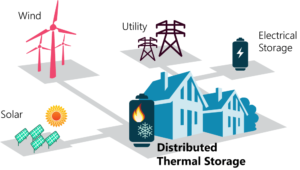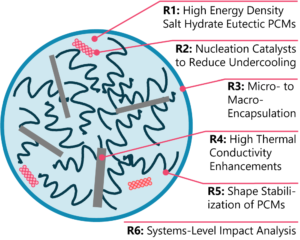Salt Hydrate Eutectic Thermal Energy Storage for Building Thermal Regulation – DOE / EERE / BTO
Senior Personnel: P. Shamberger (PI), C. Culp (Co-PI), J. Felts (Co-PI), E. Pentzer (Co-PI), S. Sukhishvili (Co-PI), C. Yu (Co-PI)

Thermal energy storage is anticipated to play an important role in developing the power grid of the future – a power grid that meets increasing demands of users, is resistant to disruptions, but also allows for greater penetration of renewable resources. Specifically, thermal energy storage materials can be integrated into HVAC systems and building envelopes, where they can be used to shift power demands for building climate control from periods of peak demand to periods of low demand. Phase change materials (PCMs) are compelling as low-cost, high energy density thermal energy storage materials for building thermal management. However, there is a lack of high performance low-cost PCMs within the specific temperature ranges which would most effectively allow for power load shifting.
Inorganic salt hydrates represent a promising class of PCMs, but their inherent limitations cause them to be currently unavailable for reliable building applications. The overarching goals of this research effort are to:
- Discover low-cost, high volumetric density salt hydrate eutectic PCMs to store low-quality heat (0 to 60 °C)
- Introduce a high thermal conductivity matrix to reduce the time constant for energy storage to ~0.1 to 1 hr, incorporate nucleation catalysts to decrease undercooling, and utilize microencapsulation and shape stabilization approaches, minimizing moisture loss/gain, mitigating phase separation, and maintaining stable melting behavior over the lifetime of the compounds
- Evaluate the impact these systems have on peak load shifting, and the potential for overall energy savings under different climatic scenarios and building configurations.

These goals will be achieved by an integrated research program consisting of six cohesive research subtasks:
- Materials discovery of eutectic salt hydrate PCMs by using computationally predicted thermodynamic equilibria, coupled with high-throughput experimental validation
- Rapid experimental screening of nucleation catalysts identified through robust computational databases
- Embedding salt hydrate PCM into a low cost and scalable high conductivity matrix
- Microencapsulation of salt hydrate microspheres using hybrid inorganic-polymer microencapsulation approach
- Shape stabilization by thermoreversible salt hydrate salogels, and 6) Analysis of end-use using thermal simulations, and characterization of mock-up energy storage finished components.
Key Publications:
- N.C. Starvaggi, C.B. Somodi*, E.C. Barrios, P.J. Shamberger, E.B. Pentzer, Microcapsule Fabrication by ATRP at Non-Aqueous Emulsion Interfaces, Chem. Commun., 60, 4346-4349 (2024). doi: 10.1039/D4CC00736K
- K. Rajagopalan, S. Haney, P.J. Shamberger, S.A. Sukhishvili. Hybrid Polymer Salogels for Reversible Entrapment of Salt-Hydrate-Based Thermal Energy Storage Materials, ACS Appl. Engineer. Mater., 2(3), 553-562 (2024). doi: 10.1021/acsaenm.3c00522
- S. Ahmed*, D. Ibbotson*, C. Somodi*, P.J. Shamberger. Zinc Nitrate Hexahydrate Pseudobinary Eutectics for Near-Room Temperature Thermal Energy Storage, ACS Appl. Engineer. Mater., 2(3), 530-541 (2024). doi: 10.1021/acsaenm.3c00444
- A. Chakraborty, J. Noh, P.J. Shamberger, C. Yu. In-Operando Crystallization Study of Zinc Nitrate Hexahydrate Using Zinc Oxide Nucleators, in press, J Energy Storage. doi: https://doi.org/10.1002/est2.372
- A. Chakraborty, J. Noh, R. Mach, P.J. Shamberger, C. Yu. Thermal Energy Storage Composites with Preformed Expanded Graphite Matrix and Paraffin Wax for Long-term Cycling Stability and Tailored Thermal Properties, J Energy Storage, 52, 104856 (2022). doi: 10.1016/j.est.2022.104856
- S. Ahmed, R. Mach, H. Jones, F. Alamo, P.J. Shamberger, ‘Solidification of Salt Hydrate Eutectics Using Multiple Nucleation Agents’, in REWAS 2022: Energy Technologies and CO2 Management (Volume II), ed. F. Tesfaye, L. Zhang, D. Post Guillen, Z. Sun, A. Abullahi Baba, N. R. Nellameggham, M. Zhang, D. E. Verhulst, S. Alam, (TMS, 2022), pp. 139-147. doi: /10.1007/978-3-030-92559-8
- S. Ahmed, A. Hoe, F. Alamo, N. Turner, P.J. Shamberger. Experimental Determination of High Energy Density Lithium Nitrate Hydrate Eutectics, J Energy Storage, 52, 104754 (2022). doi: 10.1016/j.est.2022.104754
- K. Rajagopalan, P. Karimineghlani, X. Zhu, P.J. Shamberger, and S.A. Sukhishvili, Polymers in Molten Inorganic Salt Hydrates: Solubility and Gelation, J Mater. Chem, A, 9, 25892 (2021). doi: 10.1039/D1TA07842A.
- S. Lak, S. Ahmed, P.J. Shamberger, E.B. Pentzer. Encapsulation of Hygroscopic Liquids vis Polymer Precipitation in Non-Aqueous Emulsions, J Colloid Interface Sci, 628B, 605 (2022). doi: 10.1016/j.jcis.2022.08.083

